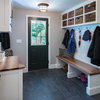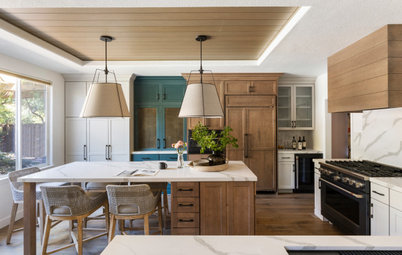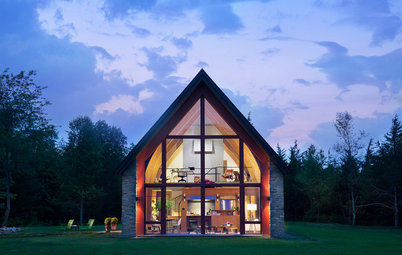Stilt Houses: 10 Reasons to Get Your House Off the Ground
Here are 10 homes that raise the stakes, plus advice on when you might want to do the same
Rebecca Gross
January 6, 2015
Design writer and historian. I write about contemporary architecture and design, and I study cultural history through the lens of architecture, design and visual culture. I have a Masters in the History of Decorative Arts and Design from Parsons The New School for Design, New York. My latest book is called "Ornament is not a crime: Contemporary Interiors with a postmodern twist."
Design writer and historian. I write about contemporary architecture and design,... More
Stilt houses date to prehistoric times and can be seen in a variety of forms worldwide. New about them are the innovative and diverse ways in which they are being designed and built. Stilt houses are well suited to coastal regions and subtropical climates. They protect against floods, maximize views and allow homeowners to build on rocky, steep or unstable land. They also keep out animals and vermin, provide ventilation under the house and minimize a house’s footprint. Here are 10 houses on wooden, steel or concrete posts or pillars that will help you understand the reasons to consider taking your house to the next level by building on stilts.
1. To build on a sloping suburban site. This neat one-bedroom studio in Brisbane, Australia, is raised above the ground on steel posts. Considering the potential for rain in the region, and the home’s site on a sloped suburban hillside, elevating the house on stilts made sense to reduce flooding, water damage and weakening of the house’s foundation. Its position higher up in the trees allows a beautiful outlook from the house.
2. To build on an unstable foundation. On a sandy dune in Fraser Island, Australia, this stilt house makes the most of sea views. The wooden poles are driven deep into the soil below the sand, anchoring the house to the ground and ensuring maximum stability.
A curved roof mimics this slope, while the platforms upon which the house is built imitate the deck of a yacht or cruise ship.
A curved roof mimics this slope, while the platforms upon which the house is built imitate the deck of a yacht or cruise ship.
3. To build on a steep coastal site. This two-bedroom vacation house sits on a steep coastal site overlooking the scenic Great Ocean Road in Victoria, Australia. While the house follows the slope of the land, steel posts elevate it. This allows for a minimal footprint on the ground and magnificent views from the house.
Find skilled home builders in your area
Find skilled home builders in your area
4. To build on uneven ground. In Scottsdale, Arizona, this minimalist, modernist house hovers above the desert floor. The steel column stilts are subtle, but in varying heights, they allow for the natural undulations of the land and the local flora to remain untouched.
5. To build over water. Inspired by Japanese architecture and its emphasis on integration with nature, this house in Maine engages both the land and water elements of its lakeside location. The living space of the house juts out over the water, supported by 14 structural steel columns. This not only makes for an unusual living space, but it also lessens the house’s mass and footprint on the fragile shore.
6. To maximize views. In beautiful Margaret River in southwest Australia, one section of this house has been elevated on stilts, leaving the hillside and flora undisturbed where possible. The design of the house takes advantage of its site. Extending the home out toward the Indian Ocean — with empty space below — has enhanced the feeling of looking out over the coast. Large glass panes allow for panoramic views.
7. To ventilate underneath the house. Many of the original homes in Queensland, Australia, are elevated on wood “stumps.” This allows for ventilation and cool air to flow under the house, protects the main structure from termites and other pests, and enables the natural flow of water in times of torrential rain.
8. To enhance sustainable design. On Australia’s Sunshine Coast, this house has been designed with space and energy efficiency in mind. It is a series of geometric volumes neatly fitted together on varying levels with stilts of differing heights. This has created areas of shade and sun that naturally warm and cool the house throughout the day. Much of the home was built on stilts to minimize its environmental impact before, during and after construction.
Locate a sustainable design builder near you
Locate a sustainable design builder near you
9. To protect against floods. Biloxi, Mississippi, on the Gulf of Mexico, is prone to floods. To mitigate any flood damage, this house is elevated on 20 concrete pilings and wooden stilts. The raised position also takes advantage of views over the bay and provides space underneath the house to shelter vehicles and equipment.
10. Because you can … and it’s stunning. And finally, a great reason to build a stilt house is because you can. On the coast of South America, this stilt house navigates rocky and steep hillside terrain, leaving the land untouched. Its stone facade and timber structure blend beautifully with the coastal landscape, while its curved walls mimic the slope of the hillside.
Hire home builders on Houzz
More:
15 Intriguing Homes Perched Above the Earth
Ultimate Vacation: 8 Incredible Rentable Homes Around the World
Hire home builders on Houzz
More:
15 Intriguing Homes Perched Above the Earth
Ultimate Vacation: 8 Incredible Rentable Homes Around the World
Related Stories
Modern Architecture
Tour Richard Neutra’s Iconic Kaufmann Desert House Gardens
By Colin Flavin
The well-known but rarely seen symbol of desert modern architecture opened its doors for Palm Springs Modernism Week
Full Story
Pritzker Prize Winners
Japan’s Riken Yamamoto Wins the 2024 Pritzker Architecture Prize
The architect is known for creating indoor-outdoor homes and buildings that foster a strong sense of community
Full Story
Working With Pros
6 Reasons to Hire a Home Design Professional
Doing a construction project without an architect, a designer or a design-build pro can be a missed opportunity
Full Story
Modern Architecture
How to Improve the Comfort of Your Midcentury Modern Home
By Colin Flavin
You can maintain the era’s signature style in your home while improving its thermal performance
Full Story
Green Building
The Passive House: What It Is and Why You Should Care
If you don’t understand passive design, you could be throwing money out the window
Full Story
Modern Architecture
Tour the House of Tomorrow and Elvis Presley’s Honeymoon Hideaway
By Colin Flavin
The recently renovated Palm Springs home returns to glory with spectacular geometry and indoor-outdoor connections
Full Story
Earth Day
12 Pros Share the Top Sustainable Features They’re Using
Design, building and landscape pros discuss the ways they’re creating comfortable, efficient and eco-friendly homes
Full Story
Bedrooms
7 Tips for Designing Your Bedroom
Learn how to think about light, layout, circulation and views to get the bedroom of your dreams
Full Story
Pritzker Prize Winners
Sir David Alan Chipperfield Wins the 2023 Pritzker Prize
The English architect is known for honoring history and culture while creating timeless modern design
Full Story
Working With Pros
10 Times to Hire an Architect
These pros help solve design problems, manage projects, build smarter homes and much more
Full Story





































egg man
This sucks and dont trust this website because it steals your personal information. They sent me this many emails-
All i did was log on to it i didnt say my email